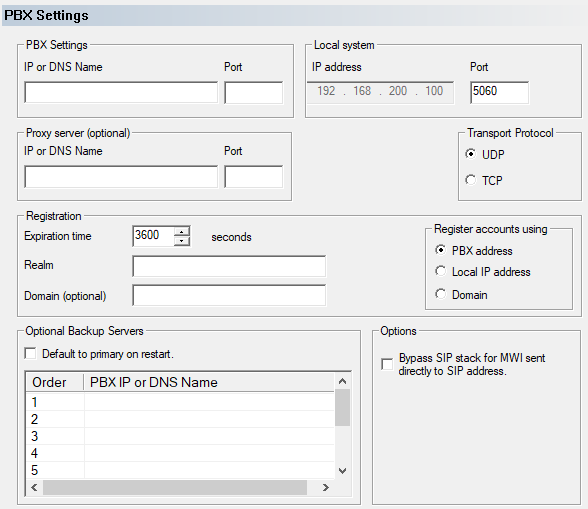PBX Settings
This page is used to configure the connection between the DV2000 and a SIP-enabled PBX.

To save your changes, click OK. To discard them, click Cancel.
PBX Settings
| Setting | Description |
|---|---|
| IP or DNS Name | IP address or DNS name of the PBX. |
| Port | Port number PBX listens on for SIP communication on. Default is 5060 |
Local System
| Setting | Description |
|---|---|
| IP Address | IP address the local SIP stack communicates with the PBX. Set based on Dialogic HMP settting. |
| Port | Port number system should listen for SIP communication on. Default is 5060 |
Proxy server
These settings are optional and typically only used when connecting to a PBX which exists on the internet rather than locally.
| Setting | Description |
|---|---|
| IP or DNS Name | IP address or DNS name of the proxy server. |
| Port | Port number proxy server uses for SIP communication on. Default is 5060 |
Transport Protocol
SIP typically communicates via UDP which is the default. If the PBX is configured for TCP only then choose TCP.
Registration
| Setting | Description |
|---|---|
| Expiration time | Enter the time, in seconds, the channel will wait between registrations with the PBX. SIP endpoints (channels) are required to maintain registration with the PBX in order to have calls routed to them. Adjust this setting to be less than the maximum for your PBX. For example, the older Avaya IP Office system default to 180 seconds, while other PBX systems have an expiration time of 3600 seconds. The default value is 3600 seconds. |
| Realm | Enter the realm with which your SIP PBX is configured. This is NOT the DNS domain. For example Asterisk realm should be set to asterisk while Avaya IP Office is ipoffice. |
| Domain | Optionally enter a domain which accounts use to login as. This is typically not set and SIP accounts are just the extension number. In some cases the account might be something like 2001@casino.com. In this case you would enter casino.com and choose to register accounts using the domain field. |
Register accounts using
Line configuration does not support the ability to enter the full address of each line. Having the setting here rather than on each line also provides quicker numerical configuration of the accounts.
| Setting | Description |
|---|---|
| PBX address | Use PBX address. Example: 2001@192.168.11.67 |
| Local IP adresss | Use PBX address. Example: 2001@192.168.11.100 |
| Domain | Use PBX address. Example: 2001@casino.com |
Optional Backup Servers
Use this table to enter up to 10 additional backup SIP registrars, with which the system can register if the main PBX/server goes offline. This is entirely optional.
The Order column indicates the order in which the servers will be checked; always configure them in the desired order of precedence, starting with server 1. For each server, enter its IP address or DNS name.
All backup servers must use the same port number, realm, expire time and transport protocol as the main server.
| Default to primary on restart | Check this box if you want the system to always attempt to register with the main server at startup. If unchecked, the system will default to using whichever server it last registered with. |
| Transport Protocol | Select the transport protocol used by the PBX. Default is UDP. |
| Register using | This setting determines what we use to register with the PBX and how we address outbound calls.
|
Options
Bypass SIP stack for MWI sent directly to SIP address
Typically only needed when using a proxy server if it will not forward direct SIP packets to extensions. When this field is checked the system will use UDP port 7060 to directly send SIP packets to the destination for MWI. This field can be changed at anytime.
Requirements
- MWI notification method must be SIP.
- Mailbox MWI address must be set to a SIP address.